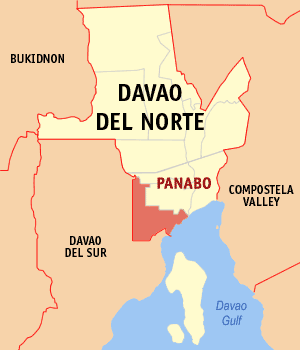FACTS ABOUT PANABO

The Banana Capital of the Philippines – Panabo, officially the City of Panabo (Cebuano: Dakbayan sa Panabo; Tagalog: Lungsod ng Panabo), is a 3rd class component city in the province of Davao del Norte, Philippines. According to the 2020 census, it has a population of 209,230 people. [3]
Panabo is part of Davao Metropolitan Area as it shares borders with Davao City. It has an area of 25,123 hectares (62,080 acres). The Panabo City Hall is located about 2.23 kilometers from its boundary with Davao City.
Country: Philippines
Region: Davao Region (XI)
Province: Davao del Norte
District: 2nd
Zip: 8105
Founded: July 19, 1949
Cityhood: March 31, 2001
Land Area: 251.23 km2 (97.00 sq mi)
Population: 209,230
Households: 41,965
Electorate: 107,587 voters as of 2019
Originally the rich lowland of what today is Panabo was inhabited by a group of stocky-haired natives called Aetas. These people led nomadic life and lived by hunting. With the use of their most essential tool, the bow and arrow—”pana-sa-boboy” as they call it—they hunted for food which primarily consisted of rootcrops and meat of wild boars.[5]
Settlers and pioneers from the Visayas and Luzon started to flock the place during the early 1900s in search of a new life in the region. When the first batch of settlers arrived on the place, in what is now the urban core of the city, they found out that it was already a thriving community, and thus called it Taboan, or trading center. Feeling alienated with the massive influx of settlers in the region, the Aeta natives moved further into the hinterlands to the west, thus ensuring that the settler inhabitants become the majority of the population. The new inhabitants started to name the place as Panabo, named after the bow and arrow that the Aeta natives always carry.
Panabo, until then only a mere barangay of Tagum, then known as Magugpo during that time, became a town on 19 July 1949, through Presidential Proclamation No. 236 of the President Manuel A. Roxas.
The Tagum Agricultural Development Company, otherwise known as TADECO, was founded on 20 December 1950 in the town of Panabo.[6] It was the birth of the world’s largest Cavendish banana plantation that saw the mass employment of the locals seeking for jobs, and the start of unprecedented growth of the town as even larger throngs of Visayan migrants settled on the town eager to join the plantation’s workforce. Large areas of forests were cleared to make way for the banana trees under TADECO. The town of Panabo grew both in economic terms and population as decades passed since the founding of TADECO and numerous businesses were then set up locally, until the conditions finally warranted for its conversion into a city.
The local government unit of Panabo was created into a component city of Davao del Norte by virtue of Republic Act No. 9015 and ratified by the residents in a plebiscite held on March 31, 2001. However, its official existence as a municipal corporation took effect on with the appointment of new set of officials.
BARANGAY
- A. O. Floirendo
- Datu Abdul Dadia
- Buenavista
- Cacao
- Cagangohan
- Consolacion
- Dapco
- Gredu (Poblacion)
- J.P. Laurel
- Kasilak
- Katipunan
- Katualan
- Kauswagan
- Kiotoy
- Little Panay
- Lower Panaga (Roxas)
- Mabunao
- Maduao
- Malativas
- Manay
Categorized in quick-facts
